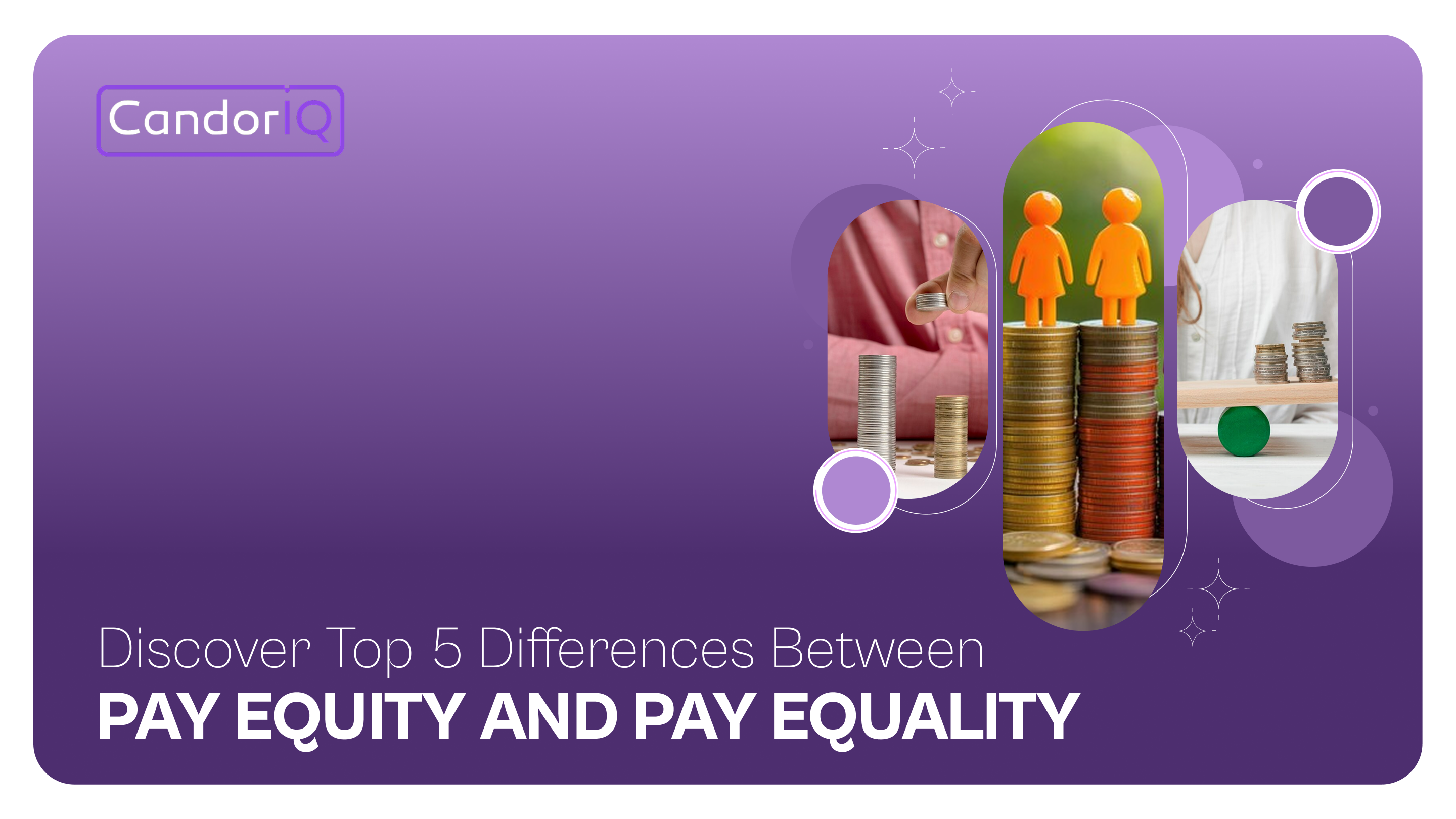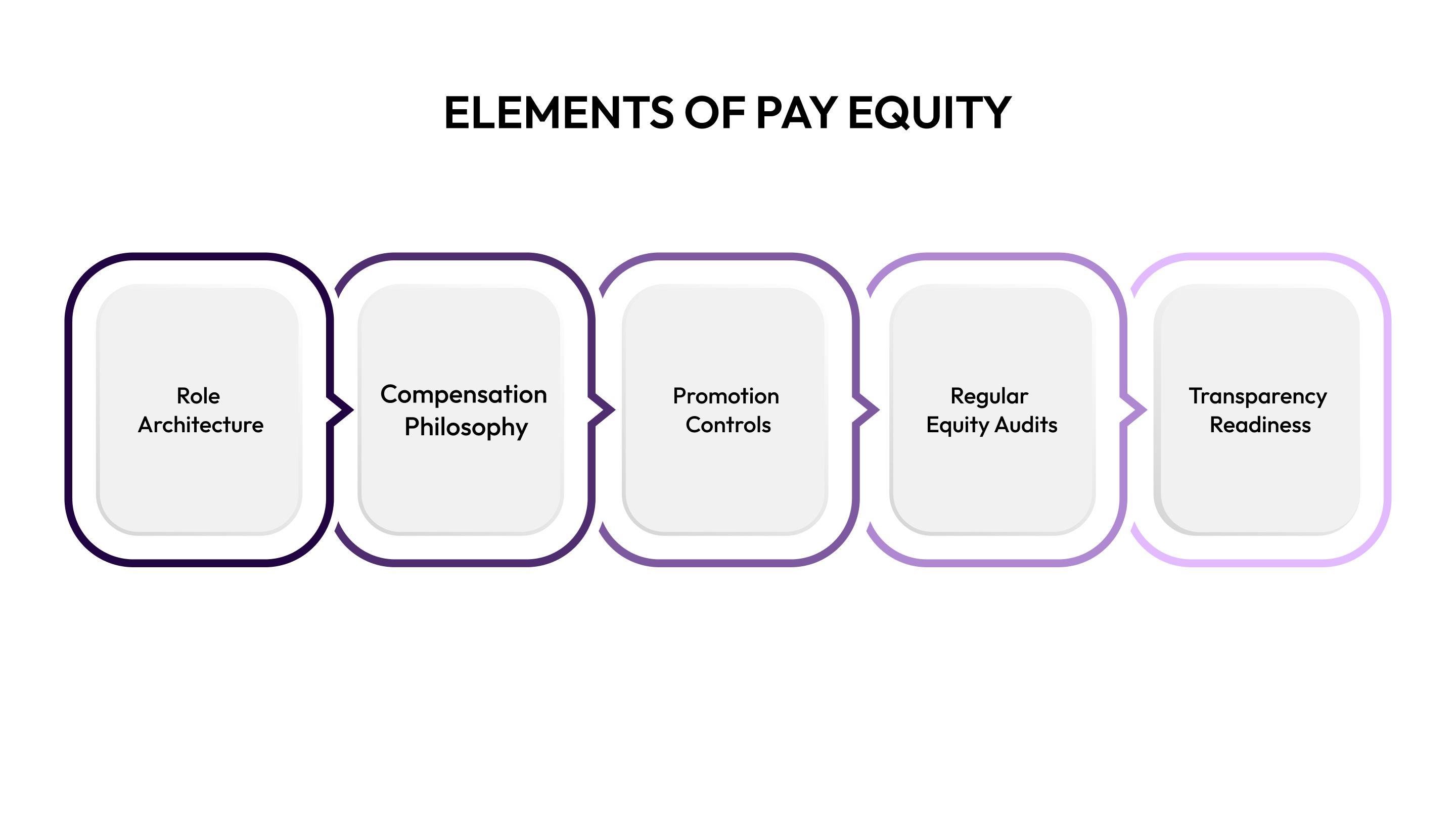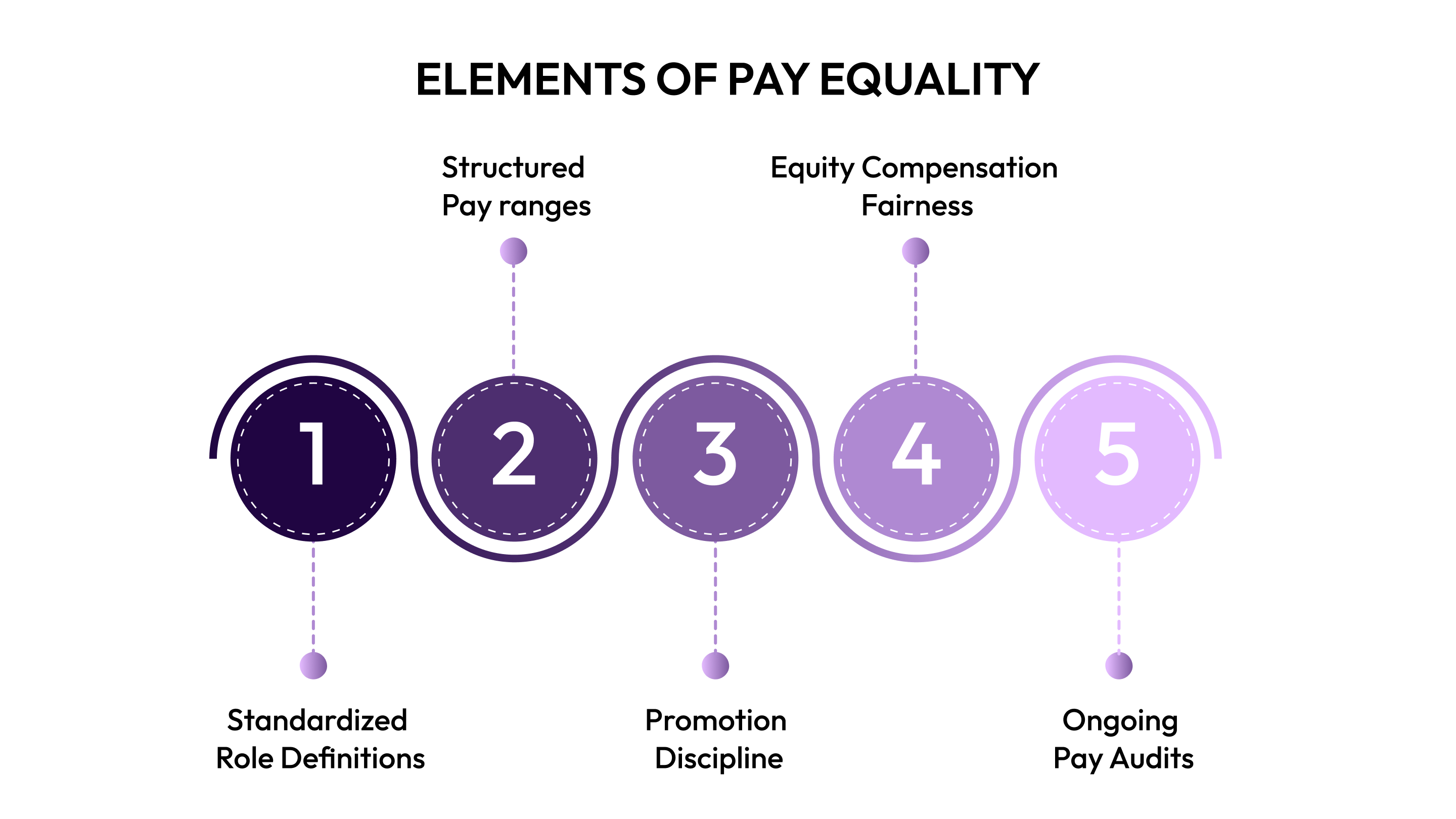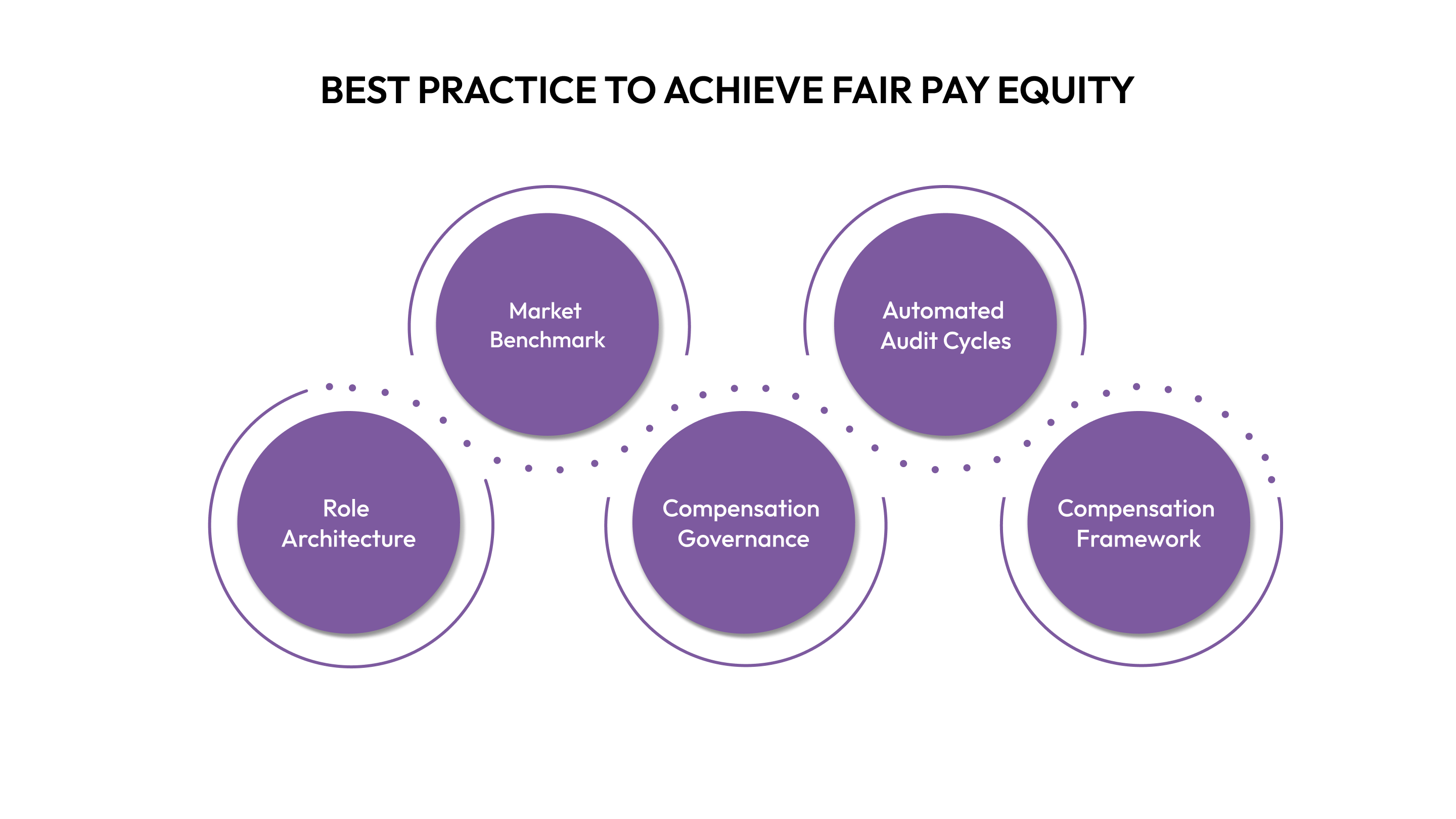Discover Top 5 Differences Between Pay Equity and Pay Equality
Learn 5 differences between pay equity and pay equality and why they matter for scaling US companies aiming to balance fairness, compliance, and retention.

What happens when two engineers at the same level, doing equally impactful work, discover one earns thousands less than the other? For growth-stage companies, that single moment can trigger retention issues, mistrust, and even compliance risk. The pressure is real, especially with distributed teams scaling from 50 to 5,000 employees, where pay practices can drift quickly.
The urgency is highlighted by the fact that in 2025, the uncontrolled gender pay gap globally stood at 0.83, meaning women earned eighty-three cents for every dollar men made. That’s not just a headline, it’s a reminder that both equity and equality carry distinct responsibilities. Many leaders conflate the two, but the difference between pay equity and pay equality is more than semantics; it shapes budgets, culture, and long-term hiring credibility.
In this guide, we’ll cover 5 key differences between pay equity and pay equality that every scaling business needs to learn.
In a Nutshell
- Equity extends beyond equality: Pay equity addresses systemic undervaluation of entire job families, while equality only checks parity within identical roles.
- Measurement matters: Adjusted regression models reveal hidden pay gaps, whereas raw equality checks risk masking structural disparities in scaling organizations.
- Offer practices shape fairness: Starting salaries anchored in structured ranges prevent compounding inequities caused by salary history reliance or ad hoc recruiter discretion.
- Beyond base salary: Equity audits must cover bonuses, commissions, and RSUs, where gender and race disparities often persist despite base pay parity.
- Transparency is strategic: Publishing salary ranges and equity policies builds trust internally while preparing for compliance with expanding US state transparency laws.
What is Pay Equity?
Pay equity is the practice of compensating employees fairly for comparable work, removing disparities tied to gender, race, or protected categories. For fast-scaling US companies, it safeguards compliance, reduces attrition risk, and strengthens hiring competitiveness.
Elements of Pay Equity

Here are the core elements that anchor pay equity in scaling companies and prevent hidden gaps from compounding as teams, roles, and budgets expand.
- Role architecture and pay bands: Clear job levels with structured pay ranges anchor comparisons, reducing manager bias, preventing compression, and protecting against inequities in distributed, growth-stage organizations.
- Compensation philosophy and governance: Documented market targets, survey benchmarks, and budget guardrails allow HR and finance to scale consistently while balancing attraction costs against long-term retention priorities.
- Offer and promotion controls: Standardized workflows for offers, promotions, and equity grants minimize inconsistent outcomes between new hires and existing employees, protecting fairness during aggressive headcount expansion.
- Regular equity audits: Scheduled reviews by gender, race, and role surface inequities early, allowing correction before legal, cultural, or financial risks escalate in a scaling company.
- Compliance and transparency readiness: Preparing for US pay transparency laws ensures readiness, avoids penalties, and signals fairness, strengthening employer credibility across SaaS, fintech, e-commerce, and professional services sectors.
While pay equity looks at fairness across roles of comparable value, pay equality narrows the lens to equal pay for employees doing the same work.
What is Pay Equality?
Pay equality refers to providing employees equal pay for equal work, eliminating unjust differences tied to gender, race, or other protected characteristics. For US growth-stage companies, it protects compliance, stabilizes retention, and strengthens recruiting outcomes in competitive markets.
Elements of Pay Equality

Here are the key elements that keep pay equality grounded and consistent as companies grow across roles, geographies, and workforce segments.
- Standardized role definitions: Clear job families and level descriptions create a consistent baseline for evaluating work, reducing manager subjectivity and preventing hidden disparities across distributed or quickly scaling teams.
- Structured pay ranges: Market-referenced salary bands applied consistently across roles and geographies help companies avoid arbitrary pay practices, controlling budget drift while maintaining fairness across workforce segments.
- Offer and promotion discipline: Defined processes for salary offers, adjustments, and promotions prevent inequities between new hires and incumbents, a common issue during aggressive expansion cycles in SaaS and fintech.
- Equity compensation fairness: Stock option and RSU (Restricted Stock Units) distribution guidelines calibrated by role and level reduce retention risks, avoiding unequal ownership stakes that undermine credibility among technical and commercial talent.
- Ongoing pay audits: Periodic reviews segmented by gender, race, and job level highlight growing disparities early, allowing correction before cultural trust, compliance exposure, or financial liabilities intensify.
To really see what the difference is between pay equity and pay equality, it helps to move past the definition and compare how each works day to day.
If you’re building fair pay practices and want a stronger foundation for your comp strategy, start by reviewing these Total Rewards and Compensation Terms You Should Know.
Key Differences Between Pay Equity and Pay Equality

Pay practices rarely fail in the obvious places; the gaps usually surface in how roles are valued, how audits are run, and how fairness is communicated. The differences between pay equity and pay equality become clear once you look at them side by side:
Difference 1: Identical Work vs. Comparable Value
Pay Equality applies strictly to identical roles, while Pay Equity covers different roles of equal value, correcting disparities that arise across job families.
Pay Equity:
- Comparable scope: Evaluates fairness across jobs requiring similar skill, effort, responsibility, and value, even if titles differ.
- Correcting undervaluation: Addresses systemic underpayment of roles historically dominated by women or minorities, such as administrative or support functions.
Pay Equality:
- Same-job focus: Limits fairness checks to employees performing the same work under the same conditions.
- One-to-one check: Centers on direct pay matching between incumbents in identical roles without broader analysis.
Difference 2: Adjusted vs. Unadjusted Pay Gaps
One of the Key Differences Between Pay Equity and Pay Equality is how disparities are measured, controlled versus raw.
Pay Equity:
- Adjusted gap: Uses regression models controlling for tenure, location, and performance to isolate unexplained pay differences.
- Data-driven analysis: Requires deeper statistical reviews, often supported by compensation tools like CandorIQ.
Pay Equality:
- Unadjusted gap: Compares average pay directly between groups in the same job without controlling for other factors.
- Simpler metric: Easier to measure, but often masks systemic inequities hidden in role design or progression patterns.
Difference 3: Legal Minimum vs. Strategic Standard
Pay Equality is firmly codified in US law, while Pay Equity sets a broader, often voluntary, standard signaling organizational commitment to fairness.
Pay Equity:
- Policy evolution: Anticipates broader expectations from regulators, investors, and employees, even where statutes are still maturing.
- Beyond compliance: Viewed as a strategic HR and finance practice to prevent long-term pay credibility risks.
Pay Equality:
- Legal anchor: Rooted in statutes like the Equal Pay Act and Title VII with clear enforcement paths.
- Minimum requirement: Provides baseline compliance but does not address structural inequities beyond identical roles.
Difference 4: Depth of Data vs. Simplicity of Checks
The Key Differences Between Pay Equity and Pay Equality also show in operational demands; equity requires complex analytics, equality relies on simpler pairwise checks.
Pay Equity:
- Multivariate modeling: Requires statistical techniques controlling for legitimate factors to expose bias.
- Cross-cohort reviews: Compare pay across functions, demographics, and geographies to surface hidden inequities.
Pay Equality:
- Pairwise comparison: Matches pay between individuals in the same job without wider analysis.
- Low analytical burden: Easier to execute for small teams, but inadequate for distributed or scaling firms.
Difference 5: Cultural Trust Signal vs. Compliance Statement
Employees interpret Pay Equity and Pay Equality differently; one signals deeper fairness, the other confirms basic compliance.
Pay Equity:
- Trust building: Shows commitment to systemic fairness, strengthening credibility with candidates and employees.
- Cultural alignment: Reinforces equity within promotion pipelines, equity grants, and long-term compensation planning.
Pay Equality:
- Baseline reassurance: Confirms no discrimination within identical roles.
- Narrow perception: May feel reactive, surfacing mostly during audits, disputes, or offer reviews.
.png)
At a Glance: Differences Between Pay Equity and Pay Equality
Seeing the key differences is one thing, but knowing how they directly impact gender pay gaps is where the real value comes through.
To keep pay equity actionable and scalable, equip your team with proven frameworks by exploring these Effective Compensation Strategies for Workforce Optimization.
Why Knowing the Difference Can Help Control Gender Pay Gaps
Closing gender pay gaps starts with knowing whether you’re comparing people in the same role or finding deeper patterns across job families, because each demands a different fix.
- Opening offer controls: Distinguishing equity from equality targets, starting pay anchors, replacing salary history and expectation tactics with ranges, structured offers, and factors that prevent compounding wage penalties.
- Adjusted vs unadjusted gaps: Applying equity regression reveals unexplained variance across families, while equality checks confirm the same job parity, guiding corrective budgets to the right cohorts, not blanket increases.
- Comparable value corrections: Equity frameworks reprice undervalued, female-dominated functions by leveling and banding, which equality alone misses, cutting structural drivers of gender gaps beyond identical job titles.
- Incentive pay calibration: Equity reviews extend to bonuses, commissions, and equity grants, where disparities often persist despite base parity, prompting quota, formula, and grant policy fixes that stick.
- Transparency strategy: Using equity and equality lenses together guides posting ranges, audit disclosures, and communication that builds trust while aligning with transparency laws and salary history bans.
Recognizing how equity and equality affect gender pay gaps is only the first step; the next is putting practices in place that keep compensation fair as you grow.
Best Practice to Achieve Fair Pay Equity

Pay equity holds up only when the structure is stronger than growth pressures. For companies scaling across roles and geographies, these practices create the guardrails that keep fairness intact:
- Role architecture consistency: Define clear job families and levels across functions to remove ambiguity, allowing HR and finance to benchmark roles consistently across distributed growth-stage organizations.
- Market benchmark application: Apply trusted, current survey data segmented by industry, geography, and company stage to maintain pay bands that reflect real market pressures in SaaS, fintech, and e-commerce.
- Compensation governance discipline: Enforce structured pay bands, promotion criteria, and equity grant frameworks that reduce subjective manager influence and control unexpected budget drift during fast workforce scaling.
- Automated audit cycles: Conduct annual or semi-annual equity reviews with regression analysis tools like CandorIQ to identify and address pay disparities across gender, race, and roles.
- Transparent compensation framework: Publish internally accessible pay philosophy, salary ranges, and equity grant guidelines, aligning employees’ expectations while preemptively supporting compliance with US state pay transparency laws.
Final Thoughts!
The Difference between pay equity and pay equality comes down to whether your company is just meeting the legal baseline or building compensation systems employees can actually trust. Growth-stage firms can’t afford to let pay drift create retention or compliance risks.
That’s where CandorIQ helps, removing bias, cutting wasted time, and giving HR and finance leaders confidence in every cycle. CandorIQ supports scaling businesses with distributed or remote-first teams, helping HR and Finance keep pay equity aligned with tighter budget governance.
With CandorIQ, you can:
- Unified Platform: CandorIQ consolidates pay bands, compensation cycles, headcount forecasting, and offer workflows into a unified platform, eliminating scattered tools and manual reconciliations.
- Simplify your merit cycle: Simplify raises, approvals, and budget tracking in one place, no spreadsheets needed.
- Reduce time spent by 50%: Automate manual processes, shorten merit cycles, and free up HR and finance bandwidth.
- Allocate budgets with precision: Track changes in real time to avoid surprises and maintain control.
- Empower managers with data: Provide transparent pay histories, performance insights, and clear guardrails for equitable decisions.
- Collaboration: Real-time collaboration features and geo-adjusted pay bands make it easier for global teams to stay aligned on fair compensation practices.

Ready to see the Difference between pay equity and pay equality in action? Book your demo with CandorIQ today.
FAQs About the Difference Between Pay Equity and Pay Equality
1. Do pay equity audits and pay equality audits measure the same thing?
No. Pay equity audits run regression models to isolate unexplained disparities across job families. Pay equality audits check if employees in identical roles receive identical pay.
2. Can a company meet pay equality standards but still fail on pay equity?
Yes. You may pay men and women equally within the same role (equality), but still undervalue entire female-dominated job categories (equity failure).
3. How does geography impact the difference between pay equity and pay equality?
Pay equality focuses narrowly on equal pay for identical jobs within the same location. Pay equity accounts for legitimate geographic differentials while controlling for bias.
4. Which carries more legal risk today, gaps in equality or gaps in equity?
In the US, pay equality gaps create immediate legal exposure under the Equal Pay Act. Pay equity gaps may create reputational or regulatory risk, depending on state laws.
5. Does equity compensation (stock, RSUs) fall under pay equality or pay equity?
Pay equality rarely addresses equity grants since it focuses on identical base pay. Pay equity explicitly covers stock and RSU fairness, critical in SaaS and fintech retention.


